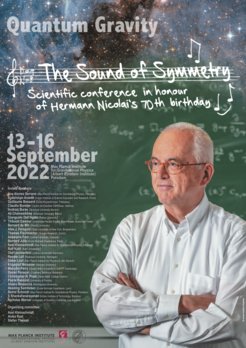HermannFest 2022
Scientific conference in honour of Hermann Nicolai’s 70th birthday
This scientific conference focuses on themes surrounding symmetries in supergravity and quantum gravity. These are central in the research of Hermann Nicolai whose contributions have sparked many important developments.

What are the consequences and incarnations of symmetry in gravity? This question has driven the research of Hermann Nicolai and many other researchers over the past decades. One outstanding question is whether supersymmetry, an attractive theoretical construction relating matter and force particles, is realised in nature. What would be the consequences at low energies or for cosmology? Combining supersymmetry with gravity one is inevitably led to supergravity model that are highly constrained and exhibit many unexpected additional features. The hidden global symmetries found in maximal supergravity have repercussions in string theory and could potentially be used to constrain the quantisation of gravity and the construction of M-theory. Are hyperbolic Kac-Moody symmetries like E10 more fundamental than supersymmetry? What is the relation of these observations to properties of the supermembrane? These and similar questions will be discussed in this conference on the occasion of Hermann Nicolai's 70th birthday.
The conference will take place from 13-16 September 2022 at the Max Planck Institute for Gravitational Physics in Potsdam. Participation is by invitation only.
See here for the programme.
Invited speakers
- Ana Alonso Serrano (MPI for Gravitational Physics, Potsdam) [SLIDES]
- Sudarshan Ananth (IISER Pune) [SLIDES]
- Guillaume Bossard (Ecole Polytechnique, Palaiseau) [SLIDES]
- Andrzej Buras (Technical University Munich) [SLIDES]
- Ali Chamseddine (American University Beirut) [SLIDES]
- Gianguido Dall'Agata (Padua University) [SLIDES]
- Thibault Damour (IHES, Bures-sur-Yvette) [SLIDES]
- Bernard de Wit (Utrecht University) [SLIDES]
- Alex J. Feingold (SUNY Binghamton) [SLIDES]
- Thomas Fischbacher (Google Research, Zurich) [SLIDES]
- Anamaría Font (Universidad Central, Caracas) [SLIDES]
- Bernard Julia (ENS Paris) [SLIDES]
- Axel Kleinschmidt (MPI for Gravitational Physics, Potsdam) [SLIDES]
- Ralf Köhl (Kiel University) [SLIDES]
- Olaf Lechtenfeld (Leibniz Universität Hannover) [SLIDES]
- Wolfgang Lerche (CERN) [SLIDES]
- Renate Loll (Radboud University, Nijmegen) [SLIDES]
- Krzysztof Meissner (Warsaw University) [SLIDES]
- Malcolm Perry (Queen Mary University & DAMTP Cambridge)
- Daniel Persson (Chalmers Technical University) [SLIDES]
- Christopher N. Pope (Texas A&M, College Station) [SLIDES]
- Pierre Ramond (University of Florida) [SLIDES]
- Alvaro Restuccia (Antofagasta University) [SLIDES]
- Henning Samtleben (ENS Lyon) [SLIDES]
- Bernd Schmidt (MPI for Gravitational Physics, Potsdam)
- S Shankaranarayanan (IIT Bombay) [SLIDES]
- Kellogg S. Stelle (Imperial College, London) [SLIDES]
- Nicholas Warner (USC Los Angeles) [SLIDES]
